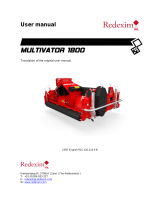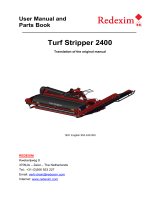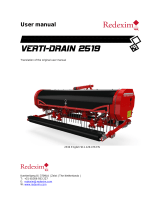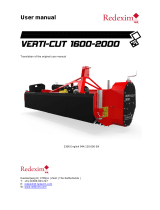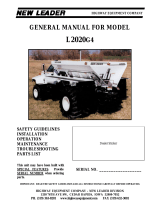Page is loading ...

- 2 - DS1600

DS1600 - 3 -
TABLE OF CONTENT
SAFETY REGULATIONS .......................................................................................... 4
SAFETY REGULATIONS .......................................................................................... 5
SHORT DESCRIPTION.............................................................................................. 6
TECHNICAL DATA .................................................................................................... 6
FIRST START-UP ...................................................................................................... 7
OPERATION .............................................................................................................. 8
Attachment and detachment ................................................................................................................ 8
Before every drive ................................................................................................................................ 9
Loading ................................................................................................................................................ 9
SPREADING .............................................................................................................10
Operating elements ............................................................................................................................ 10
- hydraulic control ........................................................................................................................ 10
- electro-hydraulic control (10551) ............................................................................................... 11
Adjusting the spreading density ......................................................................................................... 12
Spreading chart .................................................................................................................................. 12
Spread of different grit materials ........................................................................................................ 13
Disc adjustment for uneven spread pattern ....................................................................................... 13
CARE and MAINTENANCE ......................................................................................14
Lubricate bearing with multi-purpose grease (every 50 operating hours) ......................................... 14
Changing the oil on the conveyor belt gear (every 100 operating hours) .......................................... 15
Adjusting the overpressure and throttle valve ................................................................................... 15
Axle maintenance (every 100 operating hours) ................................................................................. 16
Tighten conveyor belt (in case of slipping) ........................................................................................ 16
Removing and installing the conveyor belt ........................................................................................ 17
Tightening the conveyor belt after installation ................................................................................... 17
External oil supply (17331) ................................................................................................................ 18
Lighting system (17396) ..................................................................................................................... 19
Troubleshooting ................................................................................................................................. 20
Subject to technical modifications.
Equipment marked with # is only available as optional equipment.

- 4 - DS1600
SAFETY REGULATIONS
➢ The RINK Disk Spreader DS1600 is designed exclusively for spreading fine-grained, loose
grit such as sand, gravel, granulate or similar.
➢ Any use beyond this is considered improper use. The manufacturer is not liable for any
damage resulting from this; the risk is borne solely by the user.
➢ Intended use also includes compliance with the operating, maintenance and servicing
conditions prescribed by the manufacturer.
➢ The RINK Disc Spreader DS1600 is built to the latest state of the art and is safe to operate;
however, the RINK Disc Spreader DS1600 may pose a risk to the life and limb of the user
and others if it is not used, maintained and repaired by persons who are familiar with it and
have been informed of the dangers.
➢ Every person in charge of operating, maintaining and repairing the spreader during
operation must read and understand the operating instructions, in particular the chapter on
safety regulations.
➢ Only use the manufacturer’s original spare parts for repairs.
➢ In addition to the information contained in this manual, general safety and accident
prevention regulations must also be observed.
➢ When using public roads, the respective regulations apply (German Road Traffic Licensing
Regulations (StVZO)).
➢ The spreader may only be driven on public roads after registration has been completed.
Full TÜV (MOT) certificates and additional safety equipment required for this (lighting,
wheel chocks) are available on customer request.
➢ It is not permitted to transport passengers!
➢ It is prohibited to enter the loading ramp when the spreader is in operation. A notice to
this effect is affixed to the wheel cover on both sides of the RINK Disc Spreader DS1600.
This notice must always be clearly legible and must be replaced in the event of damage.
➢ The user is obliged to inspect the RINK Disc Spreader DS1600 for visible damage and
defects before using it. Any changes to the RINK Disc Spreader DS1600 (including
operation), which may harm safety, must be rectified immediately. For safety reasons, it is
strictly forbidden to make any changes or additions to the RINK Disc Spreader DS1600
(except for changes/additions authorised by the manufacturer). In the event of
modifications being made to the RINK Disc Spreader DS1600, the CE marking currently
affixed to the machine shall become invalid and must be independently renewed by the
person who made the modifications.

DS1600 - 5 -
SAFETY REGULATIONS
➢ The permissible support load of the tractor must be observed.
➢ Before departure, check the immediate vicinity and ensure sufficient visibility.
➢ During operation, no one should be in the danger zone of the spreader, as there is a risk
of injury from rotating parts and flying foreign objects.
➢ Make sure to dress appropriately. Wear safety shoes and long trousers. Long hair must be
tied up. Do not wear loose clothing. Use appropriate personal protective equipment in
accordance with applicable occupational health and safety regulations.
➢ The RINK Disc Spreader DS1600 produces a noise of 74 dB (a) in the immediate vicinity
of the rotating discs.
➢ Wear certified hearing protection when working with the machine.
➢ Adjustment and repair work may only be carried out by authorised specialist personnel.
Always depressurise the hydraulic system before carrying out repair work. Regularly check
the hydraulic hoses and replace them if they are damaged or old. The hydraulic hoses must
comply with the technical requirements of the implement manufacturer.
Waste oil endangers the environment; please dispose of in
an environmentally friendly manner.

- 6 - DS1600
SHORT DESCRIPTION
The RINK Disc Spreader DS1600 is used for spreading fine-grained, loose grit such as sand,
gravel or similar. The spreading device of the disc spreader is driven by a gearbox with a
hydraulic motor for the conveyor belt and one hydraulic motor each for the spreading discs.
The speed of the hydraulic motors for the conveyor belt and the spreading discs is fully
adjustable via a flow regulator. The grit can thus be precisely metered. The spreading width
and spread rate can be determined by the travel speed, spreading disc speed and conveyor
belt speed.
TECHNICAL DATA
Dimensions RINK Disc Spreader DS1600
Length ................................................................................... 3.75 m
Width ..................................................................................... 2.04 m
Height.................................................................................... 1.73 m
Height (with filler plate) ......................................................... 1,97 m
Loading volume ....................................................................... 1.60 m3
Weights
Perm. total weight ................................................................. 3700 kg
Perm. axle load ..................................................................... 3200 kg
Perm. support load ............................................................... 500 kg
Unladen weight ................................................................. ... 835kg
Spread width (steplessly adjustable) ....................................... up to 12 m
Spreading density .................................................................... 0.3 - 20 mm
Tyres ......................................................................................... 4 x 26.5 x 14.00 - 12
Tyre pressure ........................................................................... 1.80 bar
Perm. maximum speed ............................................................ 25 km/h
Towing power ........................................................................... 28 KW (35 PS)
Hydraulic connection values
Oil minimum flow rate tractor ................................................ 25 l/min
Oil minimum pressure tractor ............................................... 140 bar
The type plate is attached to the front right of the spreader.

DS1600 - 7 -
FIRST START-UP
- Tighten wheel nuts.
- Check wheel hub play and adjust if necessary.
- Check tyre pressure.
- If the RINK Disc Spreader DS1600 is to be used on public roads, the registration plate
must be attached to the rear left-hand side on the mounting plate provided for this purpose
(only possible with permission to use and after registration has been completed).
- Check the lighting system.
Check these points again after the first loaded run!

- 8 - DS1600
OPERATION
Attachment and detachment
- Adjust the hitch (1) to the tractor. To do this, loosen the bolts of the hitch (1), adjust to the
correct height and retighten the bolts (see page 9 - Fig. 1).
- Hitch RINK Disc Spreader DS1600 to tractor.
- Connect hydraulic lines (3) and (4) to tractor as a closed oil circuit is required (see page 10
- Fig. 2).
- Securely attach the valve actuator (5) for the conveyor belt to the tractor using the holder
provided (see page 10 - Fig. 2).
- With external oil supply (see page 18) Place the slip-on pump on the tractor’s PTO shaft
attachment and secure it against twisting with the help of the attached torque support. The
PTO shaft may only be switched on at idle speed, as switching on the PTO shaft under
load can cause the gearbox-pump connecting pinion to break. For optimum operation, the
PTO shaft speed should be approx. 450 rpm, which corresponds to 25 l/min. The oil
temperature at the start of work should be approx. 25oC (sight glass on the oil tank), if
necessary let the hydraulic system warm-up. A too low PTO shaft speed or a too low oil
temperature will impair the spreading performance. Before beginning work, check the oil
level in the hydraulic tank (sight glass centre). The hydraulic system is filled with Plantosyn
3268 ECO hydraulic oil ex-works. Too little oil can damage or destroy the hydraulic pump.
Plug in the seven-pole connector of the lighting system on the tractor.
(see page 19 - Fig. 13).
- Crank up the support wheel (2) completely, then loosen the support wheel clamp and pull
the support wheel (2) up as far as possible and clamp it (see page 9 - Fig. 1).
Lay the hydraulic hoses so that they do not rub against the ground or the
tractor.
Detach in reverse order!
Depressurise the hydraulics on the tractor before detaching.

DS1600 - 9 -
Fig. 1: Support wheel
Before every drive
- Check RINK Disc Spreader DS1600 for externally visible damage, and repair the damage.
- Check tyre pressure.
- Check the belt track, and readjust if necessary, as the belt must not rub against the side
(see pages 16 and 17).
- Check the lighting system.
Loading
- Observe the desired maximum ground pressure.
- Observe the permissible total weight when loading.
1
2

- 10 - DS1600
SPREADING
When the hydraulics are switched on, the spreading unit is automatically activated. The
conveyor belt and the slider (6) are activated by actuating the valve (5), whereby the slider (6)
is activated first and then, with a small delay, the conveyor belt. Before starting work, preselect
slider position A-G (see page 11).
Operating elements
(1) Control for adjusting the conveyor belt speed
(2) Control for adjusting the spreading disc speed
(3) Return line
(4) Pressure line
(5) Valve actuation for conveyor belt and slider
Setting ON: Slider opens, conveyor belt starts with a delay
Setting O: Switches off the conveyor belt, slider remains open
Setting CLOSE GATE: The slider is closed as long as the switch remains activated
(6) Slider (see page 12 - Fig. 5)
(7) Guide plate (see page 13 - Fig. 6)
(8) Power supply
- hydraulic control
Fig. 2: Operating elements
1
3
5
4
2
ON 0 CLOSE GATE

DS1600 - 11 -
- electro-hydraulic control (10551)
Fig. 3: - electro-hydraulic control
Operating panel for electrohydraulic control
Fig. 4: Operating panel for electrohydraulic control
3
4
2
8
1
5
2 5 1

- 12 - DS1600
Adjusting the spreading density
The spreading density depends on:
- the speed of the tractor
- the speed of the conveyor belt - controller (1) (see page 10 Fig. 2)
- the speed of the spreading discs - controller (2) (see page 10 Fig. 2)
- the opening (A-G) of the automatic slider (6)
Spreading chart
Spread rate
Spreading
disc
Conveyor belt
Slider position
Spread
range
Controller (2)
Controller (1)
Slider (6)
Thin
8-10
8-10
A-B
10 m
Medium
6-7
8-10
C-E
8 m
Thick
4
8-10
F-G
4 m
Abb. 5: Bedienungselemente
B
D
F
6
A
C
E
G

DS1600 - 13 -
Spread of different grit materials
Different grit materials require different settings. The RINK Disc Spreader DS1600 can be
adapted to all grit materials through the following options.
- Rotation of the distributor vanes (Fig. 5)
- Adjusting the conveyor belt speed with the controller (1) (see page 10 - Fig. 2)
- Regulating the spreading disc speed with the controller (2) (see page 10 - fig. 2)
- Adjusting the opening A-G of the automatic slider (6) (see page 12 - fig. 5)
- Increasing or reducing the driving speed
- In the case of very moist material and large spreading thickness, the guide plate (7) on the
spreading unit (using nut M8) can be removed (Fig. 6)
Fig. 6: Spreading unit
Disc adjustment for uneven spread pattern
Rotation of the distributor vanes
The distributor vanes (8) can be adjusted within the slotted holes as required (fig. 7).
External material concentration - set every second vane (8) in direction X
Inside material concentration - set every second vane (8) in direction Y
Fig. 7: Spreading disc
7
XX
YY
8
8

- 14 - DS1600
CARE and MAINTENANCE
Lubricate bearing with multi-purpose grease (every 50 operating
hours)
(1) Bearings on both sides of the spreading discs
(2) Bearings on both sides of the rear transport shaft
(3) Bearings on both sides of the front transport shaft
.
(4) Bearings on both running axles
Bearings without grease nipples are maintenance-free.
Fig. 8: Lubrication points
4
1
2
3

DS1600 - 15 -
Changing the oil on the conveyor belt gear (every 100 operating
hours)
- Unscrew the filler plug (11).
- Loosen the drain plug (12) on the inside at the bottom and drain the oil.
- Screw the drain plug (12) back in with a new seal.
- Fill with 0.6 l Oil SAE85-W140.
- Screw the filler plug back in with a new seal.
Waste oil endangers the environment; please dispose in an
environmentally friendly manner.
Fig. 9: Transport gearbox
Adjusting the overpressure and throttle valve
- The overpressure valve (10) can be precisely adjusted at the hexagon socket (fig. 9).
- Throttle valve (9) (Fig. 9) to regulate the slider (6) (see page 12 - Fig. 5). Make
adjustments only when the machine is empty. Turn the throttle valve only until the slider
opens.
An incorrect adjustment will result in overpressure in the system. This can
lead to considerable damage to the machine!
10
9
12
11

- 16 - DS1600
Axle maintenance (every 100 operating hours)
Maintenance work on the axle may only be carried out by authorised
specialist personnel.
- Tighten wheel nuts.
- Check wheel hub play and adjust if necessary.
Tighten conveyor belt (in case of slipping)
- Loosen lock nut (13) on both sides.
- Tighten nut (14) evenly on both sides, clockwise, ½ revolution each, and tighten gradually.
- Tighten the lock nut (13) again on both sides.
Excessive tensioning shortens the service life of the conveyor belt!
Fig. 10: Tighten conveyor belt
1413

DS1600 - 17 -
Removing and installing the conveyor belt
- Disconnect the hydraulic plug connections and remove the spreading unit (1) by loosening
the screws (2).
- Remove wheel cover (3) on both sides.
- Remove splash guard (4) and rubber cover (5) on the right in the direction of travel.
- Remove the chassis (6) by loosening the screws (14).
- Release the tension on both sides of the conveyor belt (8) by loosening the nuts (9).
- Remove connecting screws (10) to the funnel (11).
- Loosen and remove the clamping rings of the bearing (12) (on the right in the direction of
travel).
- Loosen screws (15) on the side part (13) and pull off completely with bearing (12).
- Remove conveyor belt (8).
The installation is done in reverse order.
Fig. 11: Removing and installing the conveyor belt
Tightening the conveyor belt after installation
- When the conveyor belt is slack, mark a length of 1000 mm on both sides of the conveyor
belt.
- Tension the conveyor belt evenly on both sides with the two tension screws (see page 16
- Fig. 10) until the marked length is stretched to a maximum of 1003 mm.
- Allow the conveyor belt to warm up for approx. 30 minutes until it runs centrally between
the side guides, readjust if necessary.
The conveyor belt must not rub against the sides, otherwise it will be
damaged. When readjusting the conveyor belt, gradually tighten the side on
which the belt scrapes.
Excessive tensioning shortens the service life of the conveyor belt!
4
514
14
6
8
10
10
15
15
9
10
11
12 1513
1
2
3

- 18 - DS1600
External oil supply (17331)
Change the oil on the slip-on pump (every 100 operating hours))
- Unscrew the bleed screw (7).
- Loosen the drain plug (8) at the bottom and drain the oil.
- Screw the filler plug (7) back in with a new seal Order no.: 10779.
- Turn the slip-on pump by 180 degrees. Replace the seal on the sight glass (9)
Order no.: 10779.
- Fill oil SAE85-W140 at the drain opening (8) up to the height of the sight glass (3).
- Screw the drain plug (8) back in with a new seal Order no.: 10779.
Fig. 12: External oil supply
Changing the oil in the hydraulic tank (as required)
- Undo suction hose (1) and drain off oil.
- Screw the suction hose (1) back on.
- Remove cover (2) from the filler filter.
- Fill up to the centre of the sight glass (3) with Plantosyn 3268 ECO.
- Close cover (2).
Changing the filter on the hydraulic tank (when changing the oil or as required)
- Remove cover (6) by loosening the screws (5).
- Replace filter element (4). Order no.: 10722
- Refit cover (6) with screws (5).
This is a closed hydraulic circuit. However, to prevent possible
contamination, the return filter (4) must be replaced every 100 hours of
operation.
4
5
6
2
1
Aufsteckpumpe
zum Befüllen 180° drehen
3
7
9
8
8
7

DS1600 - 19 -
Waste oil endangers the environment; please dispose in an
environmentally friendly manner.
Lighting system (17396)
The lighting system must be connected to the tractor with the seven-pin plug.
Short designation
Function
Cable
colour
L
Indicator left
yellow
54g
(Tractor battery +)
- - -
31
Mass
white
R
Indicator right
green
58R
Taillight right
brown
54
Brake light
red
58L
Taillight left
black
Fig. 13: Wiring diagram of the 7-pin connector

- 20 - DS1600
Troubleshooting
Problem
Cause
Solution
Slider does not
open
Throttle valve set is too weak
Adjust the throttle valve (9) until the
slider opens (see page 15)
Spreading range
is too narrow
Spreading discs rotate too slowly
Increase spreading disc speed with
controller (2) (see pages 10 to 12)
Spreading density
too thin
Too little material is supplied
Spreading disc speed too high
Conveyor belt speed too slow
Enlarge slider opening
(see page 10 to 12)
Reduce spreading disc speed with
controller (2)
(see page 10 to 12)
Increase conveyor belt speed with
controller (1)
(see page 10 to 12)
Spreading density
too thick
Too much material is supplied
Spreading disc speed too low
Conveyor belt speed too high
Reduce slider opening
(see page 10 to 12)
Increase spreading disc speed with
controller (2)
(see page 10 to 12)
Reduce conveyor belt speed with
controller (1)
(see page 10 to 12)
Spread pattern
uneven
Adjustment of the distributor vanes
not correct
Set the distributor vanes (8) correctly
(see page 13)
Flow rate uneven
Conveyor belt speed too slow
Increase conveyor belt speed with
controller (1)
(see page 10 to 12)
Conveyor belt
does not start
Conveyor belt slipping
Rear drive roller and conveyor belt
do not rotate
Tighten conveyor belt
(see page 16)
Increase the pressure in the
overpressure valve (10) by turning it
clockwise a quarter of a turn.
(see page 15).
Hydraulics does
not work
Check that hoses are connected
correctly
Replace pressure (4) and return line
(3) if necessary (see page 10)
Fig. 14: Troubleshooting
/

